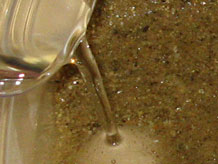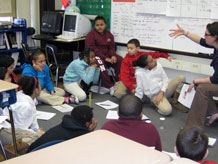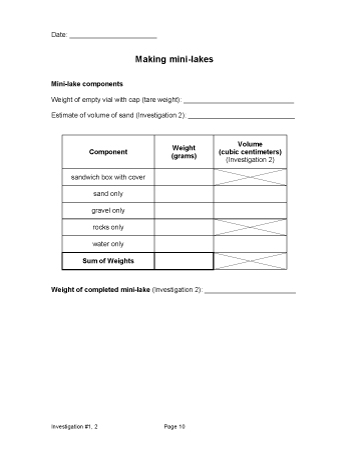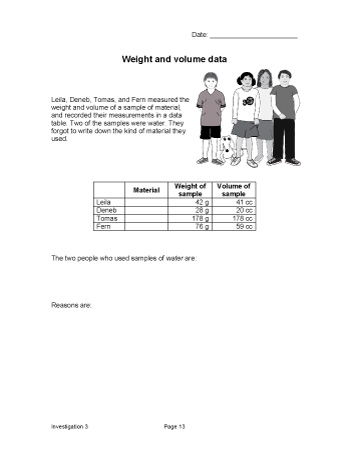How does water compare with sand?
Plan Investigation 3

In the previous investigation, students sought to explain a difference in weight between the entire mini-lake and the sum of its parts. In this investigation the issue of measurement discrepancy emerges again. The likely reason is a combination of factors: limitations of our measurement tools, and limitations of human perception.
Today, as students explore the ways in which sand and water are the same and different, they discover that a gram of sand has less volume than a gram of water. Sand is "heavy for size" in comparison with water. Students also discover that a gram of water has a volume of one cubic centimeter (and vice versa), but in the process they confront the fact that measurements do not always provide us with precisely accurate information about the quantity of matter we are investigating.
By the end of this investigation students will recognize that sand is "heavy for size" in comparison with water, that one cubic centimeter of water weighs one gram, and that the process of measurement includes taking into account possible sources of error.
Learning Goals
- Understand that one cubic centimeter of water weighs one gram and one gram of water has a volume of 1 cubic centimeter
- Understand that measurement includes taking into account possible sources of error
| Sequence of experiences | ||
|---|---|---|
| 1. Ask the question | All Class | 10 Mins |
| 2. Share the data | Small Groups | 20 Mins |
| 3. Add properties to T-chart | Discussion | 5 Mins |
| 4. Make meaning | Individual | 10 Mins |
NGSS Alignment
 Three Dimensional Learning
Three Dimensional Learning
| Disciplinary Core Ideas | 5-PS1-1, 5-PS1-2 Materials have weight and take up space and are matter. |
| Practices | Analyzing and Interpreting Data:
Students weigh samples of mini-lake materials and measure volumes. They compare the weight:volume ratios of water and sand and learn about "heavy for size" as a characteristic property of materials. Students use measurement data to establish that the weight:volume ratio of water is 1g:1cc. |
| Crosscutting Concepts | Scale, proportion and quantity: students are introduced to proportional relationships, the ratios of weight and volume in the cases of water and sand. The concept of “heavy for size,” a precursor to density, a concept that is important in multiple contexts. |
Materials and Preparation
For the class:
- Post the investigation question in a place where all students can see it.
- Make a class T-chart titled, "Comparison of Water and Sand"; an example is found in Step 1.
- Make a class data table titled, "Weight and Volume of Water and Sand" with weight data entered and sorted in Column 2; an example is found in Step 2.
For each group:
- 1 capped vial completely filled with water
- 1 capped vial completely filled with sand
Note: If possible, have teams enter their data in Columns 1, 3, and 4 prior to the start of Investigation 3. Student data is found on the [Making mini-lakes] page in the Science Notebook.
1. Ask the question
Sand and water are two of the materials used in the mini-lakes. They are also components of real lakes. Today's investigation question is:
How does water compare with sand?
Have students address the question by thinking about ways in which water and sand are the same, and ways in which they are different. Use the T-chart to record their ideas.
| Same | |
|---|---|
| Both can be poured Both have weight Both take up space |
|
| Different | |
| Water | Sand |
| transparent liquid etc. |
opaque solid etc. |
2. Share the data
Note: The full class data set can reveal patterns about the weight-volume relationship of water and sand, but it can also present students with more information than they are ready to process. Using different colors to highlight the water data column and the sand data column will help students focus on just those columns. Before starting to discuss this data, hide the Sand Volume data, and focus on just the water data.
Remind students that they have already collected lots of data about water and sand as they made their mini-lakes. They continue to think about how sand and water compare as they analyze this collection of data.
Complete the class data table Weight and Volume of Water and Sand
If they have not already done so, students should record in the table their team initials and the volumes of water and sand they used in their mini-lake. Student data is found on [Making mini-lakes] page in the Science Notebook.
Weight and Volume of Water and Sand
| Team | Weight | Water Volume | Sand Volume |
|---|---|---|---|
| Team 1 | 150g | 150cc | 94cc |
| Team 2 | 150g | 149cc | 94cc |
| Team 3 | 150g | 150cc | 92cc |
| Team 4 | 140g | 141cc | 87cc |
| Team 5 | 140g | 140cc | 88cc |
| Team 6 | 140g | 140cc | 87cc |
| Team 7 | 130g | 128cc | 82cc |
| Team 8 | 130g | 130cc | 81cc |
| Team 9 | 130g | 130cc | 81cc |
| Team10 | 120g | 120cc | 75cc |
| Team 11 | 120g | 120cc | 76cc |
| Team 12 | 120g | 122cc | 75cc |
Interactive Table (available on the website)
Review the water data
Make sure everyone has a clear view of the data table.
Highlight rows in which the Weight and Water Volume are the same. If no team has the exact same value for the weight and volume of water, highlight the rows in which the values are closest. Ask students to focus on just those rows.
What can you say about the weight and volume data in the highlighted rows?
- The weight of the water and the volume of the water are the same number (or almost the same number).
We see that (150g) of water take up (150cc) of space, and (120g) of water take up (120cc) of space. How much space do you think 50g of water will take up? (Or 1 g of water?)
- 50cc (1cc)
What do you notice about the rows that are not highlighted?
- The weight and volume are not exactly the same number, but they are very close.
Explain that making exact weight measurements is not always possible with our scales since these only measure to the nearest gram, so not all water data has the same number for weight and volume. The ones that are not the same are very close. A 1 gram difference can be considered insignificant due to the limitations of the classroom scales.
Note: When scientists created the metric system, they decided that the weight of one cubic centimeter of water would be called a gram. Each gram of water takes up exactly one cubic centimeter of space.
Use a concept cartoon as a formative assessment
Give the class a few minutes to write a response to the concept cartoon [Weight and volume data] in the Science Notebook. Explain that the task is to figure out which two students in the concept cartoon investigated a sample of water and to explain the reasons they think so. This cartoon reinforces the fact that 1cc of water weighs 1 gram, and that small errors are typically a part of measurement.
Review the sand data
Return to the class data. Reveal the Sand Volume column. Highlight the volume and the weight of sand in one row.
It may help students understand the organization of the data table if a volunteer reads the information provided in the row you have highlighted.
Example: Team 3 found a weight of 150g of water had a volume of 150cc. Team 3 found a weight of 150g of sand had a volume of 92cc.
- Each 1g of sand takes less than 1cc. 150g of sand take up 92cc of space.
Point out that sand is "heavy for its size" compared with water.
- water
Review heavy for size
Point out the containers of water and sand you have distributed. Ask students to take turns holding one in each hand and comparing the weights.
- The volumes are equal.
- The sand is heavier than the water.
Point out that as long as the volumes are equal, sand is a material that is heavy for its size compared with water. For samples of any size - as long as the size of the samples is the same, sand will weigh more than water.
- solid rock (there are no air spaces between the particles), copper, steel
- Yes, if you have a lot of water and a small amount of sand, the water will weigh more.
3. Add properties to T-chart
How does water compare with sand?
Add the new information that students have discovered as they analyzed the mini-lake data, in the T-chart, under Different:
- 1g of water equals 1cc (conversely, 1 cc of water weighs 1g.
- 1g of sand has a volume that is less than 1cc (conversely, 1cc of sand weighs more than 1g.)
Define matter
Introduce matter. Explain that matter is anything that has weight and takes up space. Since sand and water both have weight and both take up space, both of them are considered matter. Add it to the T-chart, under Same:
- Both water and sand are matter.
The rocks, gravel, and the plastic box that are used in the mini-lakes are also matter. Some examples of things that do not have weight and do not take up space include a sound, a shadow, and a dream.
4. Make meaning
Gather students in a circle. Make sure the class data table is visible to all.
Remind students that this is the second investigation in a row where measurement data were actually different than what might have been expected. Direct their attention to the class table: three groups started with the same weight of sand but the measured volumes were not always the same.
Purpose of the discussion
The purpose of this discussion is for students to jointly construct explanations regarding the discrepant sand and water data they have collected, explanations that are consistent with their observations and evidence.

Engage students in the focus question
Our data show that when water samples have equal weights, the measured volumes are not always equal. The same is true for sand. What are some possible explanations?
- The scales round measurements to the nearest gram
- There are limits to how accurately our eyes can see things.
- The way the water surface curves up when it touches the wall of the graduated cylinder makes it difficult to read the exact volume.
- When measuring the volume of sand, the surface is not perfectly flat, so it's difficult to see what the exact volume is.
- When the volume is more than 100cc's it has to be measured in two parts, because our graduated cylinders hold just 100cc. The small errors for each measurement are combined.
- Measure very carefully to avoid the errors that are possible to avoid.
- Make the same measurement twice, or have two different people make a measurement.
Summarize the discussion and recap the investigation
Using the same language students have used, summarize their main ideas. Include the following key ideas:
- Small errors are just a part of measurement and very difficult to avoid.
- Some errors are caused by the equipment we use.
- Some errors occur because our eyes cannot see exactly what the measurement really is.
As you recap the investigation, be sure there is understanding of these points:
- 1g of water has a volume of 1cc and 1g of sand has a volume that is less than 1cc.
- 1 cc of water weighs 1g and 1cc of sand weighs more than 1g.
- Both sand and water are matter because they have weight and take up space.
- Small measurement errors are almost always present. Realizing this means we can be more prepared to notice patterns even when there are small variations in the data. For example, we realize that 1g of water has a volume of 1cc, even though some of the values for volume did not exactly match the values for weight.
Reminder: Introduce 315 Dots Per Page
Don‘t forget a 5 minute introduction to 315 Dots per Page prior to Investigation 4.







